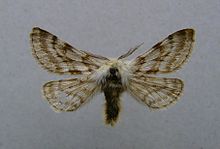Alpine tensioner
| Alpine tensioner | ||||||||||||
|---|---|---|---|---|---|---|---|---|---|---|---|---|

Alpine spanner ( Lycia alpina ) |
||||||||||||
| Systematics | ||||||||||||
|
||||||||||||
| Scientific name | ||||||||||||
| Lycia alpina | ||||||||||||
| ( Sulzer , 1776) |
The Lycia alpina ( Lycia alpina ) is a butterfly ( moth ) from the family of the tensioner (Geometridae).
features
butterfly
There is a strong sexual dimorphism between the two sexes . The male moths reach a wingspan of 28 to 40 millimeters. The forewings are whitish in color and show brownish transverse lines and transverse bands, which continue in a weakened form on the hind wings. The antennae are combed. The head and neck are covered with thick, pure white hair. The flightless females have very narrow wing stubs up to six millimeters long, a plump body shape and a blackish color with white hair. The laying scabbard is brown.
egg
The flat and oval shaped egg is colored blue-green.
Caterpillar
Adult caterpillars are greenish or yellowish in color, dotted with black dots and show a light yellow, wavy side line.
Doll
The doll is black-brown in color and has a forked tip on the stem-shaped cremaster .
Similar species
The males of the dry grass tussock ( Lycia zonaria ) are drawn with more contrast, whereas they are drawn with less contrast in Lycia florentina and Lycia graecarius . All of the aforementioned species lack white hair on the head and neck.
Geographical distribution and occurrence
The alpine spanner is widespread in the high altitudes of the Alps between 1000 and 2500 meters and in the Swiss Jura . The species can be found on mountain meadows.
Way of life
The moths form one generation a year and live between April and July, depending on the altitude. The males visit artificial light sources , the females are usually found resting on stems in the vegetation. The caterpillars live polyphagous on various low plants and develop into pupae in the same year. The pupa hibernates, sometimes several times.
Danger
In Germany, the alpine spanner occurs only in the Bavarian Alps and is included on the red list of endangered species as a type of warning list.
swell
Individual evidence
- ^ Josef Wolfsberger: New and interesting macrolepidoptera finds from southern Bavaria and the adjacent Northern Limestone Alps. In: Bavarian Entomologists' newsletter. 23. Vol. 3, 1974.
- ^ A b Walter Forster, Theodor A. Wohlfahrt: The butterflies of Central Europe. Volume 5: Spanner. (Geometridae). Franckh'sche Verlagshandlung, Stuttgart 1981, ISBN 3-440-04951-5 .
- ^ Karl Burmann: Nyssia alpina Sulz. (Lepid., Geometridae). Some life-science observations from North Tyrol. In: Journal of the Vienna Entomological Society. Volume 41, 1956 ( Online ; PDF; 850 kB)
- ↑ Federal Agency for Nature Conservation (Ed.): Red List of Endangered Animals in Germany . Landwirtschaftsverlag, Münster 1998, ISBN 3-89624-110-9 .
literature
- Walter Forster , Theodor A. Wohlfahrt : The butterflies of Central Europe. Volume 5: Spanner. (Geometridae). Franckh'sche Verlagshandlung, Stuttgart 1981, ISBN 3-440-04951-5 .
Web links
- Lepiforum eV taxonomy and photos
- www.pyrgus.de Photos and ecology
- www.schmetterlinge-deutschlands.de Endangerment
- Lycia alpina at Fauna Europaea. Retrieved April 12, 2011


